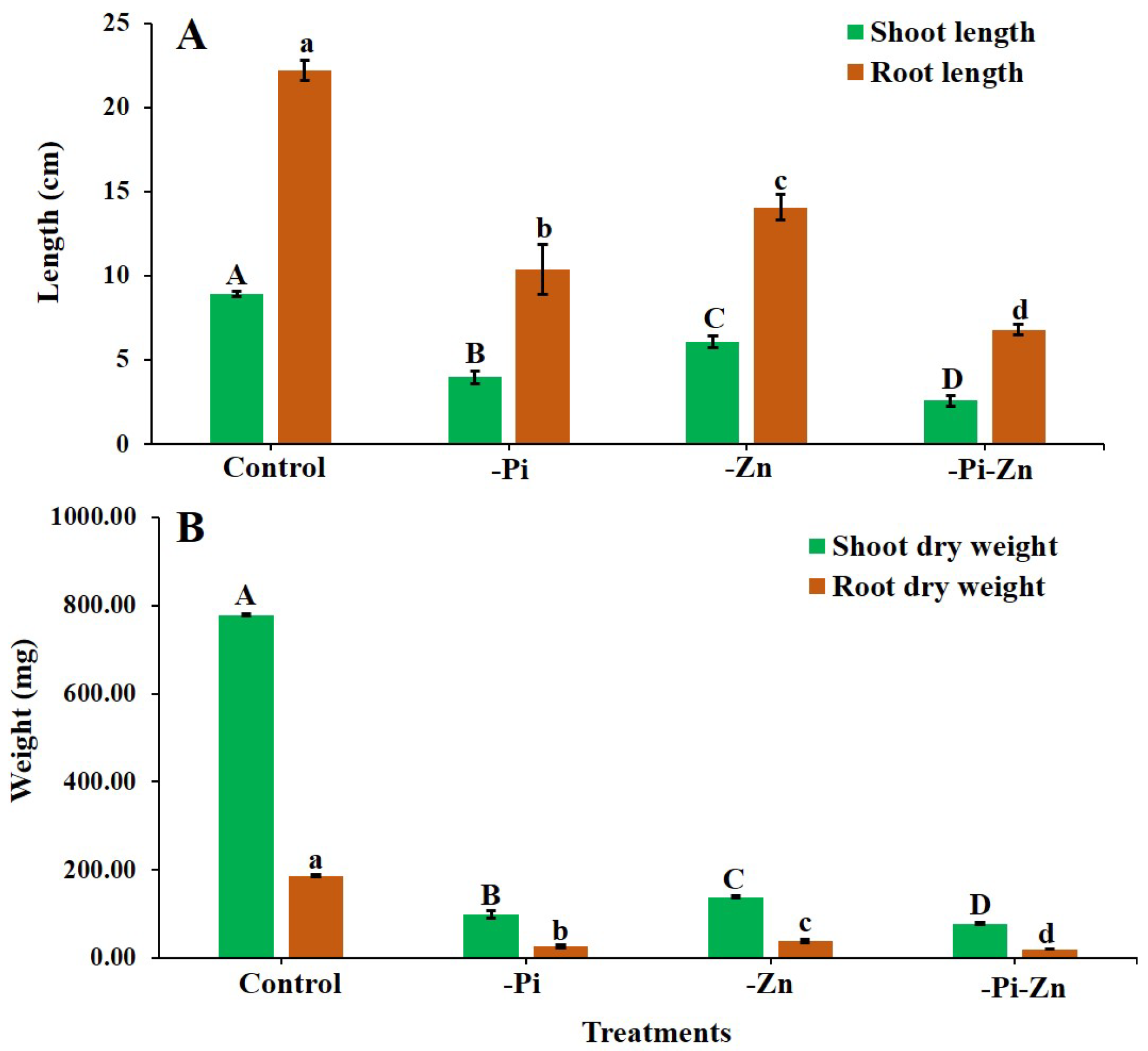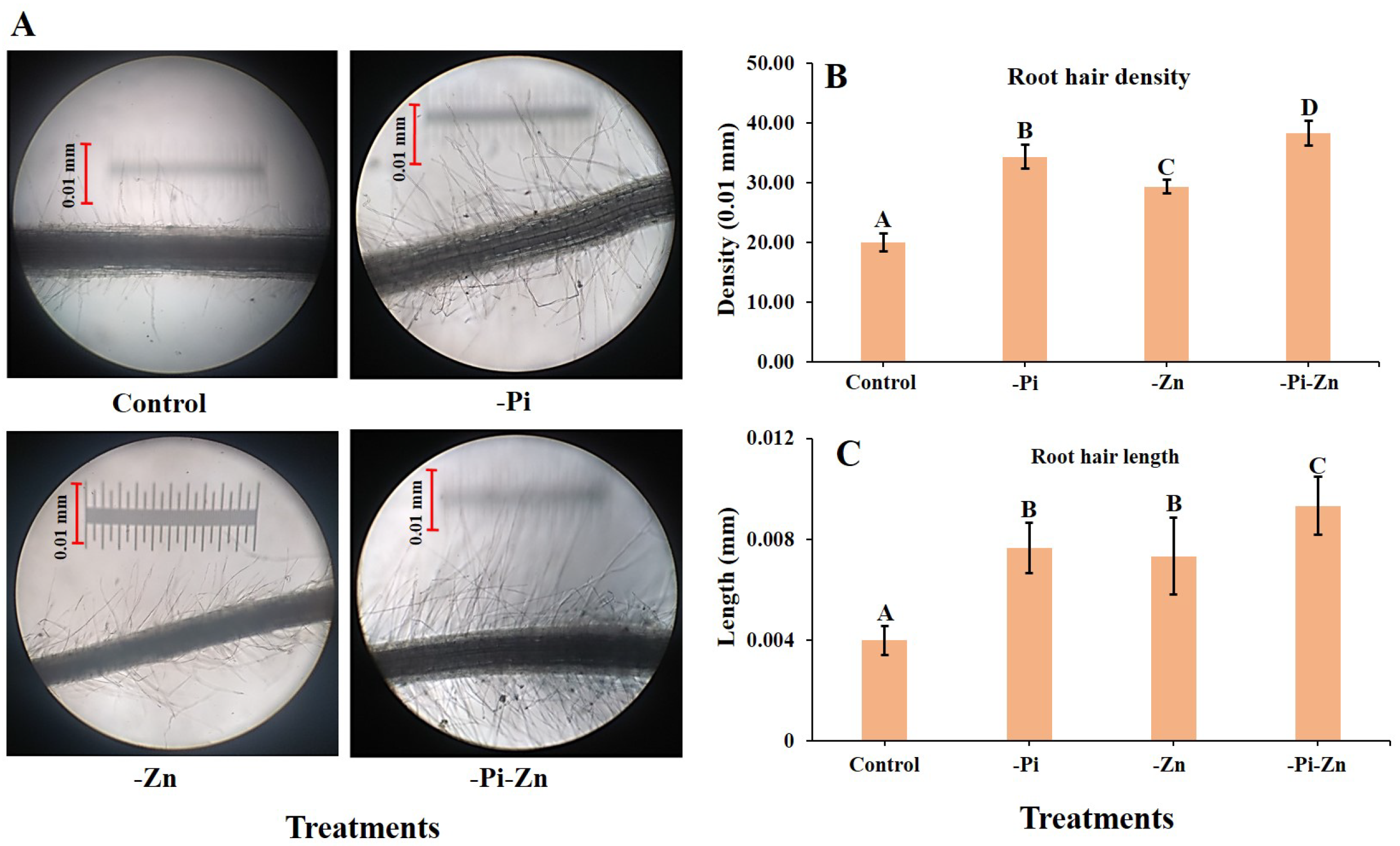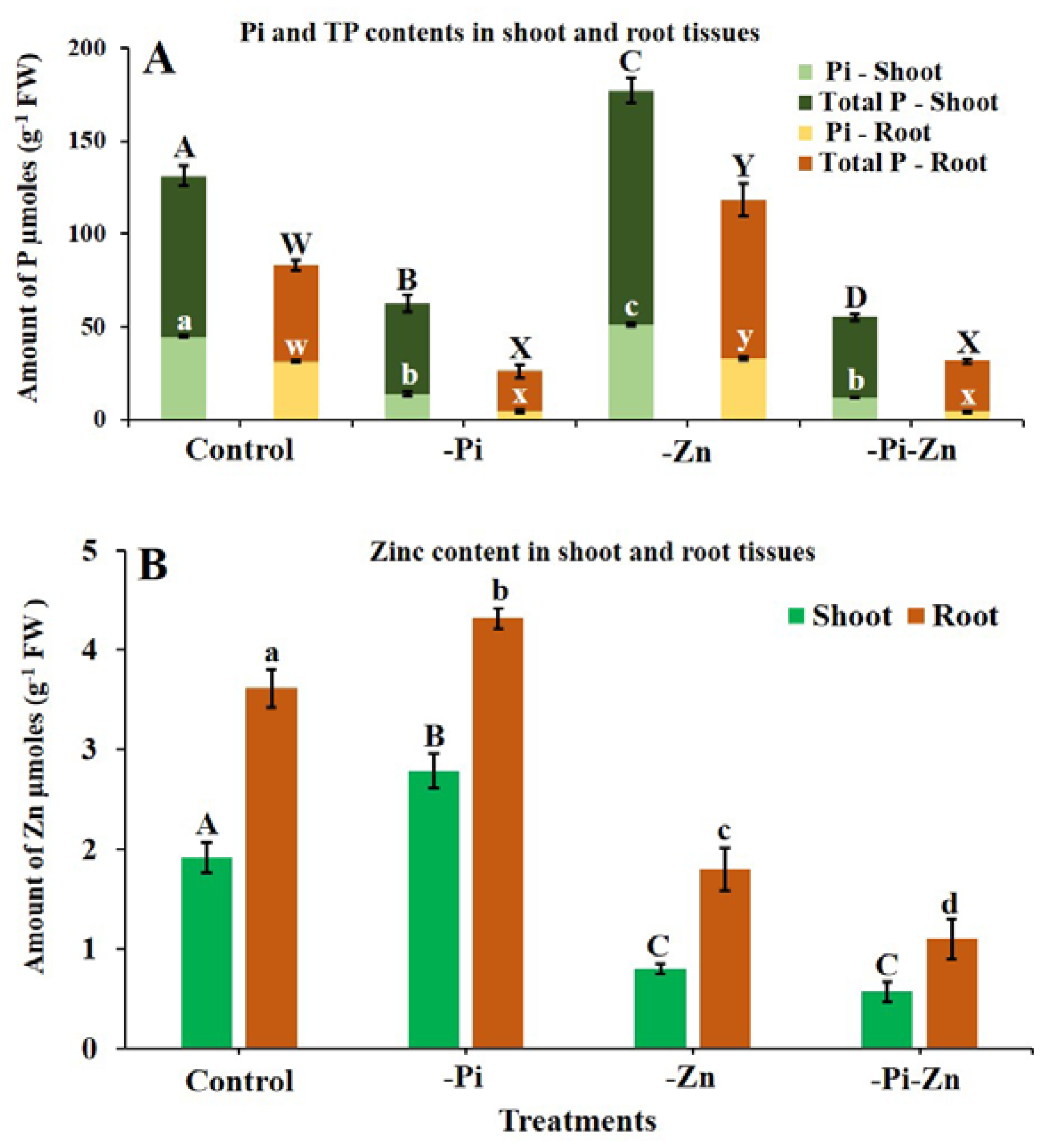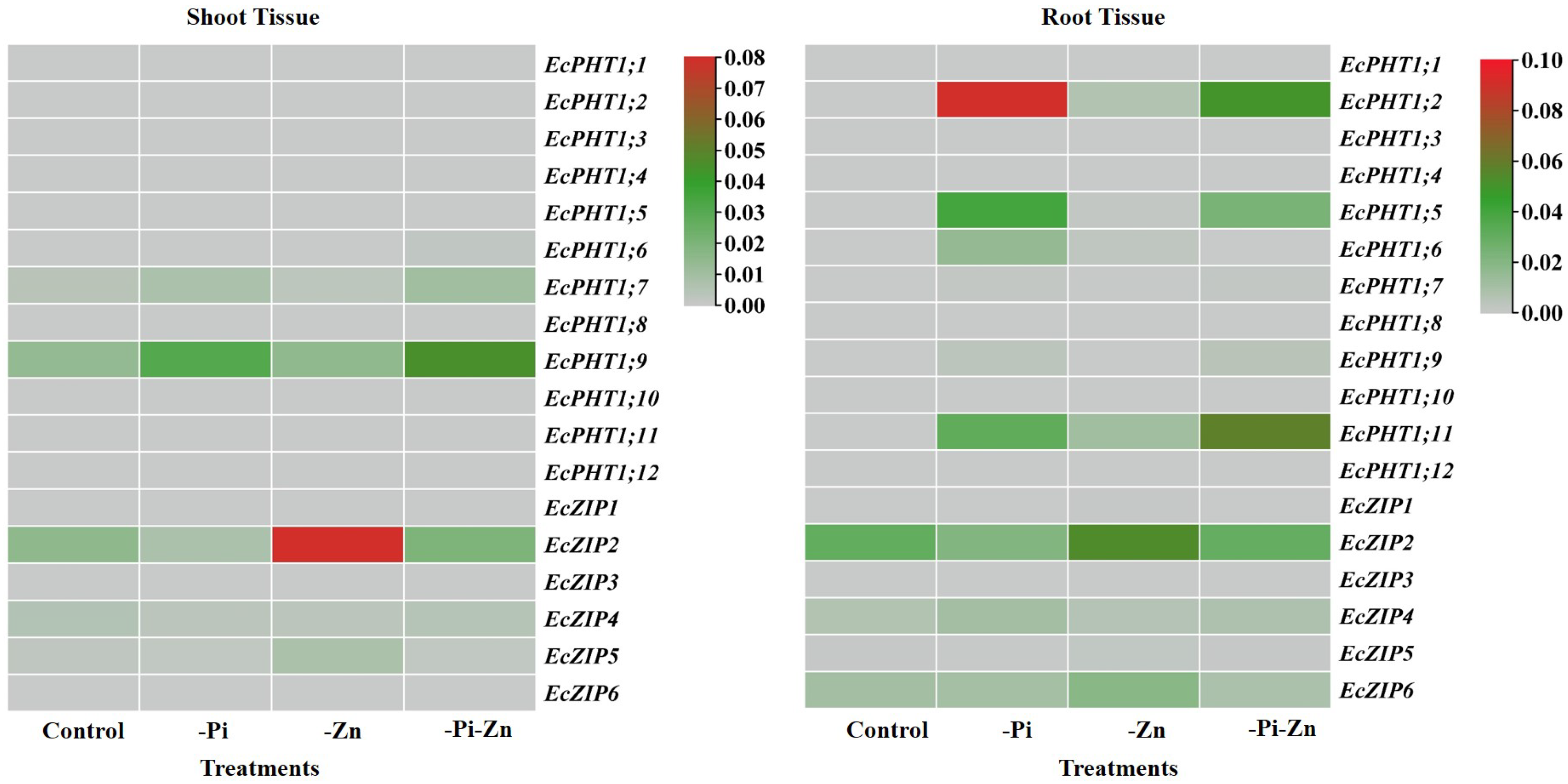Effects of Individual or Combined Deficiency of Phosphorous and Zinc on Phenotypic, Nutrient Uptake, and Molecular Responses of Finger Millet (Eleusine coracana): A Nutri-Rich Cereal Crop
Abstract
:1. Introduction
2. Results and Discussion
2.1. Phenotypic and Biochemical Changes under Individual or Combined Deficiency of Pi and Zn
2.1.1. Individual or Combined Deficiency of Pi and Zn Influenced Seedling Growth and Biomass
2.1.2. Individual or Combined Deficiency of Pi and Zn Influenced the Root Hair Modification
2.1.3. Individual or Combined Deficiency of Pi and Zn Influenced the Pi and Zn Content
2.1.4. Individual or Combined Deficiency of Pi and Zn Influenced the Expression of EcPHT1 and EcZIP Family Genes
3. Materials and Methods
3.1. Foundation Study to This Experiment
3.2. Plant Growth Experiments
3.3. Phenotypic and Biochemical Analysis
3.4. RNA Isolation and cDNA Synthesis
3.5. qRT-PCR Analysis
3.6. Statistical Analysis
4. Conclusions
Supplementary Materials
Author Contributions
Funding
Data Availability Statement
Acknowledgments
Conflicts of Interest
References
- Saleh, A.S.M.; Zhang, Q.; Chen, J.; Shen, Q. Millet Grains: Nutritional Quality, Processing, and Potential Health Benefits. Compr. Rev. Food Sci. Food Saf. 2013, 12, 281–295. [Google Scholar] [CrossRef]
- Amadou, I.; Gounga, M.E.; Le, G.-W. Millets: Nutritional Composition, Some Health Benefits and Processing—A Review. Emirates J. Food Agric. 2013, 25, 501–508. [Google Scholar] [CrossRef]
- Puranik, S.; Kam, J.; Sahu, P.P.; Yadav, R.; Srivastava, R.K.; Ojulong, H.; Yadav, R. Harnessing finger millet to combat calcium deficiency in humans: Challenges and prospects. Front. Plant Sci. 2017, 8, 1311. [Google Scholar] [CrossRef]
- Saleem, S.; Mushtaq, N.U.; Shah, W.H.; Rasool, A.; Hakeem, K.R.; Rehman, R.U. Morpho-physiological, biochemical and molecular adaptation of millets to abiotic stresses: A review. Phyton 2021, 90, 1363. [Google Scholar] [CrossRef]
- Numan, M.; Serba, D.D.; Ligaba-Osena, A. Alternative strategies for multi-stress tolerance and yield improvement in millets. Genes 2021, 12, 739. [Google Scholar] [CrossRef]
- Ramakrishnan, M.; Ceasar, S.A.; Vinod, K.K.; Duraipandiyan, V.; Ajeesh Krishna, T.P.; Upadhyaya, H.D.; Al-Dhabi, N.A.; Ignacimuthu, S. Identification of Putative QTLs for Seedling Stage Phosphorus Starvation Response in Finger Millet (Eleusine Coracana L. Gaertn.) by Association Mapping and Cross Species Synteny Analysis. PLoS ONE 2017, 12, e0183261. [Google Scholar] [CrossRef] [PubMed]
- Maharajan, T.; Ajeesh Krishna, T.P.; Rakkammal, K.; Ramakrishnan, M.; Ceasar, S.A.; Ramesh, M.; Ignacimuthu, S. Identification of QTL Associated with Agro-Morphological and Phosphorus Content Traits in Finger Millet under Differential Phosphorus Supply via Linkage Mapping. Agriculture 2023, 13, 262. [Google Scholar] [CrossRef]
- Maharajan, T.; Ceasar, S.A.; Krishna, T.P.A.; Ignacimuthu, S. Phosphate Supply Influenced the Growth, Yield and Expression of PHT1 Family Phosphate Transporters in Seven Millets. Planta 2019, 250, 1433–1448. [Google Scholar] [CrossRef]
- Ceasar, S.A.; Ramakrishnan, M.; Vinod, K.K.; Roch, G.V.; Upadhyaya, H.D.; Baker, A.; Ignacimuthu, S. Phenotypic Responses of Foxtail Millet (Setaria Italica) Genotypes to Phosphate Supply under Greenhouse and Natural Field Conditions. PLoS ONE 2020, 15, e0233896. [Google Scholar] [CrossRef] [PubMed]
- Roch, G.V.; Maharajan, T.; Krishna, T.P.; Ignacimuthu, S.; Ceasar, S.A. Expression of PHT1 Family Transporter Genes Contributes for Low Phosphate Stress Tolerance in Foxtail Millet (Setaria Italica) Genotypes. Planta 2020, 252, 98. [Google Scholar] [CrossRef] [PubMed]
- Ajeesh Krishna, T.P.; Maharajan, T.; Antony Ceasar, S.; Ignacimuthu, S. Zinc supply influences the root-specific traits with the expression of root architecture modulating genes in millets. J. Soil Sci. Plant Nut. 2023, 1–15. [Google Scholar] [CrossRef]
- Nussaume, L.; Kanno, S.; Javot, H.; Marin, E.; Pochon, N.; Ayadi, A.; Thibaud, M.C. Phosphate import in plants: Focus on the PHT1 transporters. Front. Plant Sci. 2011, 2, 83. [Google Scholar] [CrossRef]
- Solangi, F.; Zhu, X.; Khan, S.; Rais, N.; Majeed, A.; Sabir, M.A.; Kayabasi, E.T. The Global Dilemma of Soil Legacy Phosphorus and Its Improvement Strategies under Recent Changes in Agro-Ecosystem Sustainability. ACS Omega 2023, 8, 23271–23282. [Google Scholar] [CrossRef] [PubMed]
- Lambers, H. Phosphorus acquisition and utilization in plants. Ann. Rev. Plant Biol. 2022, 73, 17–42. [Google Scholar] [CrossRef] [PubMed]
- Sharma, A.; Patni, B.; Shankhdhar, D.; Shankhdhar, S.C. Zinc—An indispensable micronutrient. Physiol. Mol. Biol. Plants 2013, 19, 11–20. [Google Scholar] [CrossRef] [PubMed]
- Guerinot, M.L. The ZIP family of metal transporters. Biochim. Biophys. Acta-Biomembr. 2000, 1465, 190–198. [Google Scholar] [CrossRef]
- Huang, C.; Barker, S.J.; Langridge, P.; Smith, F.W.; Graham, R.D. Zinc Deficiency Up-Regulates Expression of High-Affinity Phosphate Transporter Genes in Both Phosphate-Sufficient and-Deficient Barley Roots. Plant Physiol. 2000, 124, 415–422. [Google Scholar] [CrossRef]
- Verma, T.S.; Minhas, R.S. Zinc and Phosphorus Interaction in a Wheat-Maize Cropping System. Fertil. Res. 1987, 13, 77–86. [Google Scholar] [CrossRef]
- Gianquinto, G.; Abu-Rayyan, A.; Di Tola, L.; Piccotino, D.; Pezzarossa, B. Interaction Effects of Phosphorus and Zinc on Photosynthesis, Growth and Yield of Dwarf Bean Grown in Two Environments. Plant Soil 2000, 220, 219–228. [Google Scholar] [CrossRef]
- Khan, G.A.; Bouraine, S.; Wege, S.; Li, Y.; de Carbonnel, M.; Berthomieu, P.; Poirier, Y.; Rouached, H. Coordination between Zinc and Phosphate Homeostasis Involves the Transcription Factor PHR1, the Phosphate Exporter PHO1, and Its Homologue PHO1; H3 in Arabidopsis. J. Exp. Bot. 2014, 65, 871–884. [Google Scholar] [CrossRef] [PubMed]
- Natasha, N.; Shahid, M.; Bibi, I.; Iqbal, J.; Khalid, S.; Murtaza, B.; Arshad, M. Zinc in soil-plant-human system: A data-analysis review. Sci. Total Environ. 2022, 808, 152024. [Google Scholar] [CrossRef] [PubMed]
- Fan, X.; Zhou, X.; Chen, H.; Tang, M.; Xie, X. Cross-Talks Between Macro- and Micronutrient Uptake and Signaling in Plants. Front. Plant Sci. 2021, 12, 663477. [Google Scholar] [CrossRef] [PubMed]
- Jain, A.; Sinilal, B.; Dhandapani, G.; Meagher, R.B.; Sahi, S.V. Effects of deficiency and excess of zinc on morphophysiological traits and spatiotemporal regulation of zinc-responsive genes reveal incidence of cross talk between micro-and macronutrients. Environ. Sci. Technol. 2013, 47, 5327–5335. [Google Scholar] [CrossRef]
- Ova, E.A.; Kutman, U.B.; Ozturk, L.; Cakmak, I. High Phosphorus Supply Reduced Zinc Concentration of Wheat in Native Soil but Not in Autoclaved Soil or Nutrient Solution. Plant Soil. 2015, 393, 147–162. [Google Scholar] [CrossRef]
- Bukvić, G.; Antunović, M.; Popović, S.; Rastija, M. Effect of P and Zn Fertilisation on Biomass Yield and Its Uptake by Maize Lines (Zea mays L.). Plant Soil Environ. 2003, 49, 505–510. [Google Scholar] [CrossRef]
- Nichols, B.A.; Hopkins, B.G.; Jolley, V.D.; Webb, B.L.; Greenwood, B.G.; Buck, J.R. Phosphorus and Zinc Interactions and Their Relationships with Other Nutrients in Maize Grown in Chelator-Buffered Nutrient Solution. J. Plant Nutr. 2012, 35, 123–141. [Google Scholar] [CrossRef]
- Rahman, K.M.M.; Chowdhury, M.A.K.; Sharmeen, F.; Sarkar, A.; Hye, M.A.; Biswas, G.C.; Sarkar, A. Effect of Zinc and Phosphorus on Yield of Oryza Sativa (Cv. Br-11). Bangladesh Res. Pub. J. 2011, 5, 315–358. [Google Scholar]
- Ding, J.; Liu, L.; Wang, C.; Shi, L.; Xu, F.; Cai, H. High Level of Zinc Triggers Phosphorus Starvation by Inhibiting Root-to-Shoot Translocation and Preferential Distribution of Phosphorus in Rice Plants. Environ. Pollut. 2021, 277, 116778. [Google Scholar] [CrossRef]
- Singh, A.P.; Singh, M. Effect of Phosphorus and Zinc on Yield and Nutrient Uptake by Okra (Abelmoschus Esculentus L.) under Different Salinity Conditions. Int. J. Chem. Stud. 2017, 5, 284–288. [Google Scholar]
- Li, H.; Zhu, Y.; Smith, S.E.; Smith, F.A. Phosphorus–Zinc Interactions in Two Barley Cultivars Differing in Phosphorus and Zinc Efficiencies. J. Plant Nutr. 2003, 26, 1085–1099. [Google Scholar] [CrossRef]
- Zhu, Y.-G.; Smith, F.A.; Smith, S.E. Phosphorus Efficiencies and Their Effects on Zn, Cu, and Mn Nutrition of Different Barley (Hordeum vulgare) Cultivars Grown in Sand Culture. Aust. J. Agric. Res. 2002, 53, 211–216. [Google Scholar] [CrossRef]
- Xu, J.; Wang, X.; Zhu, H.; Yu, F. Maize Genotypes with Different Zinc Efficiency in Response to Low Zinc Stress and Heterogeneous Zinc Supply. Front. Plant Sci. 2021, 12, 736658. [Google Scholar] [CrossRef]
- Genc, Y.; Huang, C.Y.; Langridge, P. A Study of the Role of Root Morphological Traits in Growth of Barley in Zinc-Deficient Soil. J. Exp. Bot. 2007, 58, 2775–2784. [Google Scholar] [CrossRef] [PubMed]
- Ming, F.; Zheng, X.; Mi, G.; Zhu, L.; Zhang, F. Detection and Verification of Quantitative Trait Loci Affecting Tolerance to Low Phosphorus in Rice. J. Plant Nutr. 2001, 24, 1399–1408. [Google Scholar] [CrossRef]
- Yuan, Y.; Zhang, M.; Zheng, H.; Kong, F.; Guo, Y.; Zhao, Y.; An, Y. Detection of QTL for Phosphorus Efficiency and Biomass Traits at the Seedling Stage in Wheat. Cereal Res. Commun. 2020, 48, 517–524. [Google Scholar] [CrossRef]
- Liang, Q.; Cheng, X.; Mei, M.; Yan, X.; Liao, H. QTL Analysis of Root Traits as Related to Phosphorus Efficiency in Soybean. Ann. Bot. 2010, 106, 223–234. [Google Scholar] [CrossRef]
- Xing, G.; Ma, J.; Liu, X.; Lei, B.; Wang, G.; Hou, S.; Han, Y. Influence of Different Nitrogen, Phosphorus, and Potassium Fertilizer Ratios on the Agronomic and Quality Traits of Foxtail Millet. Agronomy 2023, 13, 2005. [Google Scholar] [CrossRef]
- Ma, Z.; Bielenberg, D.G.; Brown, K.M.; Lynch, J.P. Regulation of Root Hair Density by Phosphorus Availability in Arabidopsis thaliana. Plant. Cell Environ. 2001, 24, 459–467. [Google Scholar] [CrossRef]
- Muller, M.; Schmidt, W. Environmentally Induced Plasticity of Root Hair Development in Arabidopsis. Plant Physiol. 2004, 134, 409–419. [Google Scholar] [CrossRef]
- Zhao, K.; Wu, Y. Effects of Zn Deficiency and Bicarbonate on the Growth and Photosynthetic Characteristics of Four Plant Species. PLoS ONE 2017, 12, e0169812. [Google Scholar] [CrossRef]
- Zhu, J.; Kaeppler, S.M.; Lynch, J.P. Mapping of QTL Controlling Root Hair Length in Maize (Zea mays L.) under Phosphorus Deficiency. Plant Soil 2005, 270, 299–310. [Google Scholar] [CrossRef]
- Brown, L.K.; George, T.S.; Thompson, J.A.; Wright, G.; Lyon, J.; Dupuy, L.; Hubbard, S.F.; White, P.J. What Are the Implications of Variation in Root Hair Length on Tolerance to Phosphorus Deficiency in Combination with Water Stress in Barley (Hordeum vulgare)? Ann. Bot. 2012, 110, 319–328. [Google Scholar] [CrossRef]
- Wang, Y.S.; Jensen, L.S.; Magid, J. Differential Responses of Root and Root Hair Traits of Spring Wheat Genotypes to Phosphorus Deficiency in Solution Culture. Plant Soil Environ. 2016, 62, 540–546. [Google Scholar] [CrossRef]
- Mallikarjuna, M.G.; Thirunavukkarasu, N.; Sharma, R.; Shiriga, K.; Hossain, F.; Bhat, J.S.; Mithra, A.C.R.; Marla, S.S.; Manjaiah, K.M.; Rao, A.R. Comparative Transcriptome Analysis of Iron and Zinc Deficiency in Maize (Zea mays L.). Plants 2020, 9, 1812. [Google Scholar] [CrossRef]
- Saengwilai, P.; Strock, C.; Rangarajan, H.; Chimungu, J.; Salungyu, J.; Lynch, J.P. Root Hair Phenotypes Influence Nitrogen Acquisition in Maize. Ann. Bot. 2021, 128, 849–858. [Google Scholar] [CrossRef]
- Mehra, P.; Pandey, B.K.; Giri, J. Comparative Morphophysiological Analyses and Molecular Profiling Reveal Pi-Efficient Strategies of a Traditional Rice Genotype. Front. Plant Sci. 2016, 6, 1184. [Google Scholar] [CrossRef]
- Sun, Y.; Mu, C.; Chen, Y.; Kong, X.; Xu, Y.; Zheng, H.; Zhang, H.; Wang, Q.; Xue, Y.; Li, Z. Comparative Transcript Profiling of Maize Inbreds in Response to Long-Term Phosphorus Deficiency Stress. Plant Physiol. Biochem. 2016, 109, 467–481. [Google Scholar] [CrossRef] [PubMed]
- Zhu, Y.-G.; Smith, S.E.; Smith, F.A. Zinc (Zn)-Phosphorus (P) Interactions in Two Cultivars of Spring Wheat (Triticum aestivum L.) Differing in P Uptake Efficiency. Ann. Bot. 2001, 88, 941–945. [Google Scholar] [CrossRef]
- Cakmak, I.; Marschner, H. Mechanism of phosphorus-induced zinc deficiency in cotton. III. Changes in physiological availability of zinc in plants is mail. Physiol. Plant. 1987, 70, 13–20. [Google Scholar] [CrossRef]
- Saenchai, C.; Bouain, N.; Kisko, M.; Prom-U-Thai, C.; Doumas, P.; Rouached, H. The Involvement of OsPHO1; 1 in the Regulation of Iron Transport through Integration of Phosphate and Zinc Deficiency Signaling. Front. Plant Sci. 2016, 7, 396. [Google Scholar] [CrossRef]
- Amin, S.; Zaharah, A.R.; Che, F.I.; Hanafi, M.M.; Hamed, Z. Interaction Effects of Phosphorus and Zinc on Their Uptake and 32P Absorption and Translocation in Sweet Corn (Zea mays Var. Saccharata) Grown in a Tropical Soil. Asian J. Plant Sci. 2014, 13, 129–135. [Google Scholar]
- Oseni, T.O. Growth and Zinc Uptake of Sorghum and Cowpea in Response to Phosphorus and Zinc Fertilization. World J. Agric. Sci. 2009, 5, 670–674. [Google Scholar]
- Soltangheisi, A.; Ishak, C.F.; Musa, H.M.; Zakikhani, H.; Rahman, Z.A. Phosphorus and zinc uptake and their interaction effect on dry matter and chlorophyll content of sweet corn (Zea mays var. saccharata). J. Agron. 2013, 12, 187–192. [Google Scholar] [CrossRef]
- Suganya, A.; Saravanan, A.; Manivannan, N. Role of zinc nutrition for increasing zinc availability, uptake, yield, and quality of maize (Zea mays L.) grains: An overview. Commun. Soil Sci. Plant Anal. 2020, 51, 2001–2021. [Google Scholar]
- Kisko, M.; Bouain, N.; Rouached, A.; Choudhary, S.P.; Rouached, H. Molecular Mechanisms of Phosphate and Zinc Signalling Crosstalk in Plants: Phosphate and Zinc Loading into Root Xylem in Arabidopsis. Environ. Exp. Bot. 2015, 114, 57–64. [Google Scholar] [CrossRef]
- Mandal, B.; Mandal, L.N. Effect of Phosphorus Application on Transformation of Zinc Fraction in Soil and on the Zinc Nutrition of Lowland Rice. Plant Soil. 1990, 121, 115–123. [Google Scholar] [CrossRef]
- Maharajan, T.; Krishna, T.P.A.; Ceasar, S.A.; Ignacimuthu, S. Zinc Supply Influenced the Growth, Yield, Zinc Content, and Expression of ZIP Family Transporters in Sorghum. Planta 2023, 257, 44. [Google Scholar] [CrossRef] [PubMed]
- Yang, X.W.; Tian, X.H.; Lu, X.C.; Cao, Y.X.; Chen, Z.H. Impacts of phosphorus and zinc levels on phosphorus and zinc nutrition and phytic acid concentration in wheat (Triticum aestivum L.). J. Sci. Food Agric. 2011, 91, 2322–2328. [Google Scholar] [CrossRef]
- Kisko, M.; Bouain, N.; Safi, A.; Medici, A.; Akkers, R.C.; Secco, D.; Rouached, H. LPCAT1 controls phosphate homeostasis in a zinc-dependent manner. eLife 2018, 7, e32077. [Google Scholar] [CrossRef] [PubMed]
- Kambe, T.; Tsuji, T.; Hashimoto, A.; Itsumura, N. The physiological, biochemical, and molecular roles of zinc transporters in zinc homeostasis and metabolism. Physiol. Rev. 2015, 95, 749–784. [Google Scholar] [CrossRef]
- Hamzah Saleem, M.; Usman, K.; Rizwan, M.; Al Jabri, H.; Alsafran, M. Functions and strategies for enhancing zinc availability in plants for sustainable agriculture. Front. Plant Sci. 2022, 13, 1033092. [Google Scholar] [CrossRef]
- Talke, I.N.; Hanikenne, M.; Krämer, U. Zinc-Dependent Global Transcriptional Control, Transcriptional Deregulation, and Higher Gene Copy Number for Genes in Metal Homeostasis of the Hyperaccumulator Arabidopsis halleri. Plant Physiol. 2006, 142, 148–167. [Google Scholar] [CrossRef]
- Mondal, T.K.; Ganie, S.A.; Rana, M.K.; Sharma, T.R. Genome-Wide Analysis of Zinc Transporter Genes of Maize (Zea mays). Plant Mol. Biol. Report. 2014, 32, 605–616. [Google Scholar] [CrossRef]
- Wang, J.; Yang, Y.; Liao, L.; Xu, J.; Liang, X.; Liu, W. Genome-wide identification and functional characterization of the phosphate transporter gene family in Sorghum. Biomolecules 2019, 9, 670. [Google Scholar] [CrossRef]
- Walder, F.; Brulé, D.; Koegel, S.; Wiemken, A.; Boller, T.; Courty, P.E. Plant phosphorus acquisition in a common mycorrhizal network: Regulation of phosphate transporter genes of the Pht1 family in sorghum and flax. New Phytol. 2015, 205, 1632–1645. [Google Scholar] [CrossRef] [PubMed]
- Qin, L.; Guo, Y.; Chen, L.; Liang, R.; Gu, M.; Xu, G.; Liao, H. Functional characterization of 14 Pht1 family genes in yeast and their expressions in response to nutrient starvation in soybean. PLoS ONE 2012, 7, e47726. [Google Scholar] [CrossRef]
- Shin, H.; Shin, H.S.; Dewbre, G.R.; Harrison, M.J. Phosphate transport in Arabidopsis: Pht1; 1 and Pht1; 4 play a major role in phosphate acquisition from both low-and high-phosphate environments. Plant J. 2004, 39, 629–642. [Google Scholar] [CrossRef] [PubMed]
- Ai, P.; Sun, S.; Zhao, J.; Fan, X.; Xin, W.; Guo, Q.; Yu, L.; Shen, Q.; Wu, P.; Miller, A.J. Two Rice Phosphate Transporters, OsPht1; 2 and OsPht1; 6, Have Different Functions and Kinetic Properties in Uptake and Translocation. Plant J. 2009, 57, 798–809. [Google Scholar] [CrossRef]
- Teng, W.; Zhao, Y.-Y.; Zhao, X.-Q.; He, X.; Ma, W.-Y.; Deng, Y.; Chen, X.-P.; Tong, Y.-P. Genome-Wide Identification, Characterization, and Expression Analysis of PHT1 Phosphate Transporters in Wheat. Front. Plant Sci. 2017, 8, 543. [Google Scholar] [CrossRef]
- Grün, A.; Buchner, P.; Broadley, M.R.; Hawkesford, M.J. Identification and Expression Profiling of Pht1 Phosphate Transporters in Wheat in Controlled Environments and in the Field. Plant Biol. 2018, 20, 374–389. [Google Scholar] [CrossRef] [PubMed]
- Ceasar, S.A.; Hodge, A.; Baker, A.; Baldwin, S.A. Phosphate Concentration and Arbuscular Mycorrhizal Colonisation Influence the Growth, Yield and Expression of Twelve PHT1 Family Phosphate Transporters in Foxtail Millet (Setaria italica). PLoS ONE 2014, 9, e108459. [Google Scholar] [CrossRef] [PubMed]
- Maharajan, T.; Ceasar, S.A.; Ajeesh Krishna, T.P. Finger millet (Eleusine coracana (L.) Gaertn): Nutritional importance and nutrient transporters. Crit. Rev. Plant Sci. 2022, 41, 1–31. [Google Scholar] [CrossRef]
- Soleimani, B.; Sammler, R.; Backhaus, A.; Beschow, H.; Schumann, E.; Mock, H.P.; Pillen, K. Genetic regulation of growth and nutrient content under phosphorus deficiency in the wild barley introgression library S42IL. Plant Breed. 2017, 136, 892–907. [Google Scholar] [CrossRef]
- Webb, M.J.; Loneragan, J.F. Effect of zinc deficiency on growth, phosphorus concentration, and phosphorus toxicity of wheat plants. Soil Sci. Soc. Am. J. 1988, 52, 1676–1680. [Google Scholar] [CrossRef]
- Naeem, A.; Aslam, M.; Lodhi, A. Improved potassium nutrition retrieves phosphorus-induced decrease in zinc uptake and grain zinc concentration of wheat. J. Sci. Food Agric. 2018, 98, 4351–4356. [Google Scholar] [CrossRef]
- Bouain, N.; Kisko, M.; Rouached, A.; Dauzat, M.; Lacombe, B.; Belgaroui, N.; Rouached, H. Phosphate/zinc interaction analysis in two lettuce varieties reveals contrasting effects on biomass, photosynthesis, and dynamics of Pi transport. BioMed. Res. Int. 2014, 2014, 548254. [Google Scholar] [CrossRef] [PubMed]




| Gene Name | Forward Primer (5′–3′) | Reverse Primer (5′–3′) | Product Length (bp) | Tm (°C) |
|---|---|---|---|---|
| EcPHT1;1 | GTTCTGCATCTCCCTTGTCTC | AATGAGCGTGAAGCCGTAGAC | 202 | 60.1 |
| EcPHT1;2 | CCTGATCCTCATGGTGCTAT | AGAGGGTAGTCACCGCCTAT | 129 | 58.9 |
| EcPHT1;3 | TTATCCACTATCCGCGACCA | CGAGATGATGAGCGTGACAA | 130 | 58.1 |
| EcPHT1;4 | CAACAGCACCACCTTCGT | CCTAGCATGTTGGTGATGGA | 195 | 58.9 |
| EcPHT1;5 | GCTGCGCTCACTTACTACTGG | CACCTGCTCATCGTCTTCC | 141 | 59.5 |
| EcPHT1;6 | GCCATGCTCACCTACTACTGG | CGACTTGCAGAACCTTGGAC | 115 | 60.6 |
| EcPHT1;7 | CCTCCACATGGACATCAGTG | CATGGCGATGCAGAAACTG | 110 | 58.9 |
| EcPHT1;8 | ACGGTCTTCCAGTGCTCGT | GTTCACGGTCGCGTTCATC | 117 | 59.3 |
| EcPHT1;9 | CAAGCGGATTTCGTGTGG | ACCTTTGACATGTCTGCTGCT | 152 | 57.6 |
| EcPHT1;10 | CTTGACGAGCTGTACCACATC | ATATGGTTCTCCGCGGTCTT | 200 | 59.3 |
| EcPHT1;11 | GGTGTACCTCGCAGTTTCC | TGTCACGCTCATCATCTCG | 187 | 58.9 |
| EcPHT1;12 | GTGTACGGCTTCACTCTCATC | CGTCGCTGATAATGGATAGTCTC | 153 | 60.1 |
| EcZIP1 | GACTCGCTCATGCTCACCTT | TGGTCCTTGTCTGCACCATC | 159 | 59.3 |
| EcZIP2 | CCTGTGACACAACTACGGAAC | TCGTTGAGGACGAGCACAAG | 158 | 59.8 |
| EcZIP3 | GGCAATGACAGTCCTCCTC | CCACCACCTGGTCCTTATT | 127 | 57.8 |
| EcZIP4 | CACCTGGTGAAACGACAGTG | TGGAGATTGGGATTGTGTTC | 110 | 57.5 |
| EcZIP5 | CTCCTCTGGTGAATTGATGAC | TGAGCAACATGGAGATGAGG | 118 | 57.5 |
| EcZIP6 | GCGTCATCGTTGCAGTAGC | ACCACCAGCAGCAGACTC | 110 | 58.6 |
| EcEF1-α | CCTGGTGATAATGTGGGATTC | TAGCCATTGCCGATCTGTC | 161 | 59.7 |
Disclaimer/Publisher’s Note: The statements, opinions and data contained in all publications are solely those of the individual author(s) and contributor(s) and not of MDPI and/or the editor(s). MDPI and/or the editor(s) disclaim responsibility for any injury to people or property resulting from any ideas, methods, instructions or products referred to in the content. |
© 2023 by the authors. Licensee MDPI, Basel, Switzerland. This article is an open access article distributed under the terms and conditions of the Creative Commons Attribution (CC BY) license (https://creativecommons.org/licenses/by/4.0/).
Share and Cite
Maharajan, T.; Krishna, T.P.A.; Shilpha, J.; Ceasar, S.A. Effects of Individual or Combined Deficiency of Phosphorous and Zinc on Phenotypic, Nutrient Uptake, and Molecular Responses of Finger Millet (Eleusine coracana): A Nutri-Rich Cereal Crop. Plants 2023, 12, 3378. https://doi.org/10.3390/plants12193378
Maharajan T, Krishna TPA, Shilpha J, Ceasar SA. Effects of Individual or Combined Deficiency of Phosphorous and Zinc on Phenotypic, Nutrient Uptake, and Molecular Responses of Finger Millet (Eleusine coracana): A Nutri-Rich Cereal Crop. Plants. 2023; 12(19):3378. https://doi.org/10.3390/plants12193378
Chicago/Turabian StyleMaharajan, Theivanayagam, Thumadath Palayullaparambil Ajeesh Krishna, Jayabalan Shilpha, and Stanislaus Antony Ceasar. 2023. "Effects of Individual or Combined Deficiency of Phosphorous and Zinc on Phenotypic, Nutrient Uptake, and Molecular Responses of Finger Millet (Eleusine coracana): A Nutri-Rich Cereal Crop" Plants 12, no. 19: 3378. https://doi.org/10.3390/plants12193378





